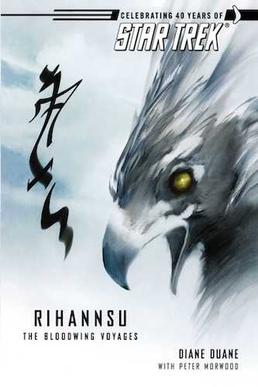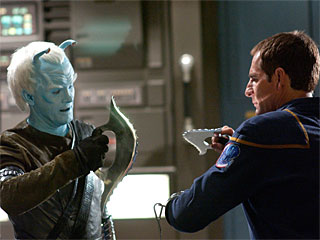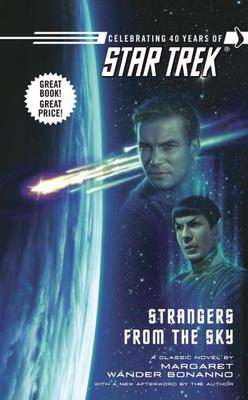
The Romulans are an extraterrestrial race in the American science fiction franchise Star Trek. They first appeared in the series Star Trek (1966–1969). They have appeared in most subsequent Star Trek releases, including The Animated Series, The Next Generation, Deep Space Nine, Voyager, Enterprise, Discovery, Picard, Strange New Worlds, and Lower Decks. They appear in the Star Trek feature films Star Trek V: The Final Frontier (1989), Star Trek VI: The Undiscovered Country (1991), Star Trek: Nemesis (2002) and Star Trek (2009). They also appear in various other spin-off media, including books, comics, toys and games.

Vulcans, sometimes referred to as Vulcanians, are a fictional extraterrestrial humanoid species in the Star Trek universe and media franchise. In the various Star Trek television series and films, they are noted for their attempt to live by logic and reason with as little interference from emotion as possible. Known for their pronounced eyebrows and pointed ears, they originate from the fictional planet Vulcan. In the Star Trek universe, they were the first extraterrestrial species to make contact with humans.

Captain Christopher "Chris" Pike is a fictional character in the Star Trek science fiction franchise. He is the immediate predecessor to James T. Kirk as captain of the starship USS Enterprise.

Jonathan Archer is a fictional character in the Star Trek franchise. He is one of the protagonists of the television series Star Trek: Enterprise, where he was portrayed by Scott Bakula.

The Gorn are a fictional extraterrestrial humanoid reptilian species in the American science fiction franchise Star Trek. They first appeared in a 1967 episode of the original series, "Arena", in which Captain Kirk fights an unnamed Gorn on a rocky planet. The fight scene has become one of the best-remembered scenes of the original series, in part due to the slow and lumbering movement of the Gorn, which some viewers have considered unintentionally comical.

Surak is a fictional character in the backstory of the Star Trek television series and franchises. He is portrayed as the most important philosopher in the history of the planet Vulcan. During an Earth-like "modern age", when the Vulcans are technological but emotionally driven and violent, Surak founds a movement which reforms the Vulcan way of thinking and lifestyle and leads to the world of logically-reasoning and emotion-suppressing Vulcans known from the TV series. This period in Vulcan history is referred to as the "Time of Awakening".

Saavik is a fictional character in the Star Trek universe. She first appeared in the film Star Trek II: The Wrath of Khan (1982) played by Kirstie Alley. Robin Curtis took over the role for Star Trek III: The Search for Spock (1984) and Star Trek IV: The Voyage Home (1986).

"Unification" is a two-part episode of the syndicated American science fiction television series Star Trek: The Next Generation which features Leonard Nimoy as Spock. The first of the two episodes earned a 15.4 household Nielsen rating, drawing over 25 million viewers, making it one of the most watched episodes in all seven seasons of The Next Generation's run.

Star Trek: Rihannsu is a series of interlinked novels, written by Diane Duane and Peter Morwood, published by Pocket Books from 1984 to 2006. The series name was retroactively applied to the first novels with the release of new installments in 2000. A fifth novel was published in 2006.
"Kir'Shara" is the ninth episode of the fourth season of the American science fiction television series Star Trek: Enterprise. It was writer Michael Sussman's third episode of the season, while it was director David Livingston's second. The episode was the third in a three-part story arc, following on from the episodes "The Forge" and "Awakening". The title "Kir'Shara" refers to a Vulcan religious relic, and the three part Vulcan story arc explored themes relating to the Protestant Reformation resulting in comparisons to books such as The Da Vinci Code and The Celestine Prophecy, while the Kir'Shara itself was compared to the Nag Hammadi library.

"United" is the 13th episode of the fourth season of the American science fiction television series Star Trek: Enterprise and the 89th episode overall. It was first broadcast on the UPN network on February 4, 2005. It is the second of a three-part story which included the previous episode "Babel One", and the following episode, "The Aenar". "United" was written by Judith and Garfield Reeves-Stevens from a story idea by show runner Manny Coto. It was directed by David Livingston, his third of the season.
"The Aenar" is the fourteenth episode of the fourth season of the American science fiction television series Star Trek: Enterprise, and originally aired on February 11, 2005. It was written by André Bormanis from a story by Manny Coto, and was directed by Mike Vejar. "The Aenar" was the third installment of a three-part story which concluded the events of episodes "Babel One" and "United".

Star Trek: The Lost Era is a series of seven thematically linked novels that explore the period between the film The Undiscovered Country and The Next Generation episode "Encounter at Farpoint". The series was conceived and edited by Mario Palmieri, and published by Pocket Books.
"Cease Fire" is the 41st episode of the television series Star Trek: Enterprise, the 15th episode of the second season. The series, set in the 22nd century of the Star Trek universe, follows the crew of Earth's faster-than-light spaceship, Enterprise, as they explore the galaxy under command of Captain Jonathan Archer.
Margaret Wander Bonanno was an American science fiction writer, ghost writer, and small press publisher. She wrote seven Star Trek novels, science fiction novels, a collaborative novel with Nichelle Nichols, a biography, and other works.

Strangers from the Sky is a novel, originally released in 1987, by Margaret Wander Bonanno.

The Devil’s Heart is the title of a 1993 non-canon Star Trek: The Next Generation novel by Carmen Carter, and the name of a legendary object of unsurpassed power and mystery which appears in that novel.

The Pandora Principle is a science fiction novel by American writer Carolyn Clowes, part of the Star Trek: The Original Series. It features the origin story of Saavik, and how she came to know Spock.














